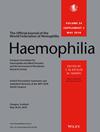Enhancing Engagement to Support Shared Decision Making Within Haemophilia: Development of Materials for People With Haemophilia, Caregivers and Healthcare Professionals
Abstract
Introduction
Treatment decision making can be complex and challenging for people with haemophilia (PwH) and their caregivers. A shared decision-making (SDM) approach can ensure that decisions about treatment and care incorporate patients’ beliefs, values, and preferences.
Aims
The aims were to: (1) identify potential drivers and barriers to SDM between PwH/caregivers and clinicians, (2) develop tools to facilitate SDM in clinic appointments, and (3) gain feedback on the usability and design of these tools to inform refinements.
Methods
Virtual focus groups were conducted with adolescent and adult PwH, caregivers of children with haemophilia, and physicians and allied health professionals (AHPs) across Canada to inform the development of tools to support SDM in clinical appointments. The usability and acceptability of the tools were examined in one-to-one interviews. These findings were used to further refine the tools.
Results
Thematic analysis from five focus groups (n = 23) identified broad themes pertaining to barriers of SDM, factors influencing treatment decisions, and strategies to facilitate SDM. Insights were used to develop an Appointment Planner including pre-appointment questions and priority setting for PwH/caregivers and a Conversational Prompt Guide including considerations for clinicians. The findings of one-to-one interviews (n = 25) indicated good usability and acceptability and informed minor refinements to the tools.
Conclusion
The study demonstrates the acceptability of specific tools to facilitate SDM based on qualitative research with the target populations. Initial feedback was positive. Further research is required to assess whether the tools can facilitate SDM by improving communication and strengthening relationships between PwH/caregivers and clinicians.


 求助内容:
求助内容: 应助结果提醒方式:
应助结果提醒方式:


